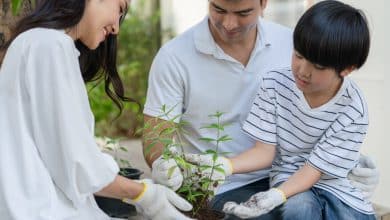Crafting a Greener World: Embrace Eco-Friendly Crafts And Hobbies for a Sustainable Lifestyle

As a society, we are becoming more conscious of our impact on the environment and are actively seeking ways to reduce waste and live sustainably. One way to do this is through eco-friendly crafts and hobbies. Not only are these activities enjoyable and fulfilling, but they also allow for creativity while promoting environmental consciousness.
When it comes to eco-friendly crafts and hobbies, there are endless possibilities. From upcycling old materials to using sustainable materials, gardening with sustainable practices, to DIY beauty and personal care products, there is something for everyone. These activities benefit the environment by reducing waste and saving you money in the long run. Plus, they provide a sense of accomplishment, knowing that you have created something unique while taking steps towards a more sustainable lifestyle. This article will explore various eco-friendly crafts and hobbies that you can easily incorporate into your daily life.
Key Takeaways
- Eco-friendly crafts and hobbies promote environmental consciousness
- Upcycling old materials reduces waste and creates unique creations
- Sustainable materials like bamboo yarn or recycled paper products reduce environmental impact in crafting hobbies
- Creating DIY beauty and personal care products at home reduces waste and exposure to harmful chemicals
Upcycle Old Materials

You can easily upcycle old materials into something new and eco-friendly that you’ll love using! Repurposing possibilities are endless, and with a little imagination and thrifty creativity, you can turn almost anything into a one-of-a-kind creation. Instead of throwing out your old clothes or household items, consider how they could be transformed into something useful.
One great way to upcycle old materials is by turning them into reusable bags. Old t-shirts or jeans can be cut and sewn into tote bags for groceries or library books. This not only saves money on buying new bags but also reduces the amount of plastic waste in landfills. You could even decorate your bags with fabric markers or iron-on patches for a personalized touch.
Another fun upcycling project is making jewelry from unexpected items like bottle caps or paper clips. With a few simple tools and some colorful beads, you can create unique pieces that are sure to catch people’s attention. Not only is this an eco-friendly option for accessorizing, but it also allows you to express your individual style in a sustainable way.
If you have kids, involving them in upcycling projects can be both educational and entertaining. For example, empty toilet paper rolls can become binoculars or kaleidoscopes with just a bit of paint and decoration. This not only encourages creativity but also teaches children about the value of repurposing materials instead of simply tossing them away.
Upcycling old materials is just one way to incorporate eco-friendly practices into your crafting hobbies. By using sustainable materials like bamboo yarn or recycled paper products, you can further reduce your environmental impact while still enjoying all the benefits of creating something beautiful with your own two hands.
Use Sustainable Materials
Using recycled materials is a piece of cake when it comes to creating sustainable crafts and hobbies. However, we can take eco-friendliness even further by using sustainable materials in our projects. Here are some ways to incorporate sustainable materials into your crafts and hobbies:
- Check out local thrift stores or online marketplaces for secondhand craft supplies.
- Use natural fibers such as hemp, linen, or organic cotton instead of synthetic fabrics.
- Look for sustainably sourced wood or bamboo for woodworking projects.
- Incorporate plant-based dyes or natural pigments instead of chemical-laden ones.
- Experiment with innovative techniques like 3D printing with biodegradable filaments.
Not only do these options contribute to a greener planet, but they also add an interesting twist to your creations. By exploring innovative techniques and using sustainable materials, you can create unique pieces that reflect your dedication to making the world a better place.
Moreover, using eco-friendly materials doesn’t mean sacrificing quality. In fact, many sustainable options boast higher durability and longevity than their conventional counterparts. For example, choosing high-quality organic cotton ensures that your finished product will be soft and long-lasting.
Incorporating sustainability into our crafts and hobbies is not only rewarding for us as creators but also benefits the environment. By adopting these simple practices into our creative pursuits, we can make a positive impact on the world around us.
As crafters who value sustainability in all aspects of life, let’s now turn our attention to gardening with sustainable practices…
Gardening with Sustainable Practices

When it comes to gardening sustainably, it’s important to consider the impact of your practices on the environment. One way to do this is by using composting tips to reduce waste and enrich soil. Composting can be done with simple materials such as a compost bin or pile, and it helps reduce methane emissions from landfills while providing a nutrient-rich soil amendment for your garden. By composting food scraps, yard trimmings, and other organic matter, you can divert waste from landfills and create a healthy ecosystem in your own backyard.
Another sustainable practice in gardening is using organic pest control methods. This means avoiding harmful chemicals that can harm beneficial insects and pollinators as well as contaminate water sources. Instead, try natural remedies like planting companion plants that repel pests or using essential oils like peppermint or neem oil to deter bugs. By working with nature instead of against it, you can create a healthier garden ecosystem that supports biodiversity.
Incorporating these sustainable practices into your gardening routine not only benefits the environment but also improves the health of your plants and ultimately yourself through the food you grow. As we continue to prioritize eco-friendly crafts and hobbies, let’s remember how our actions impact our world and take steps towards creating a more sustainable future.
Transitioning into our next topic about DIY beauty and personal care products, we’ll explore how making our own products at home can not only reduce waste but also promote healthier alternatives to store-bought items. Let’s take conscious steps towards living more sustainably in all aspects of our lives.
DIY Beauty and Personal Care Products
Creating your own beauty and personal care products at home can be a game-changer, offering an abundance of natural and affordable options that will leave you feeling like royalty. Not only do these alternatives reduce exposure to harmful chemicals commonly found in commercial products, but they also provide an opportunity to experiment with different ingredients and scents that cater to individual preferences. In addition, making your own beauty products is a great way to minimize waste by reusing containers or opting for packaging alternatives such as glass jars or biodegradable materials.
• Imagine being able to create customized fragrances that compliment your mood and personality without breaking the bank.
- Sub-list 1: Mix essential oils such as lavender, peppermint, and eucalyptus for a relaxing bath experience
- Sub-list 2: Use organic coconut oil as a moisturizer for silky smooth skin
• Think about how empowering it would feel to have control over what goes into your body care routine while simultaneously reducing environmental impact.
- Sub-list 1: Use baking soda as a natural deodorant alternative
- Sub-list 2: Create lip balms with beeswax and shea butter for soft lips all year round
Natural ingredients are not only safer for the body but also better for the environment. By switching to homemade beauty products, we can avoid contributing to plastic pollution caused by single-use containers while still enjoying high-quality skincare routines. Additionally, many natural ingredients used in DIY beauty products come from sustainable sources which further reduces our carbon footprint.
As we explore creative ways of living sustainably, making our own personal care products offers us an exciting opportunity to express ourselves creatively while taking part in eco-friendly practices. As we move onto learning about eco-friendly clothing and accessories in the next section let’s remember how small changes can make big differences when it comes down to protecting our planet’s resources.
Eco-Friendly Clothing and Accessories

Transform your wardrobe into a sustainable oasis with clothes and accessories that are both stylish and environmentally conscious. Ethical fashion has been gaining traction in recent years, encouraging consumers to be more mindful of the environmental impact of their clothing choices. This movement emphasizes transparency in the supply chain, fair labor practices, and sustainable materials. By choosing ethical fashion brands or even upcycling old clothing into new pieces, we can reduce our carbon footprint while still looking fashionable.
Another trend within eco-friendly fashion is zero-waste fashion. This approach focuses on creating garments without generating any textile waste during production. Designers use techniques such as pattern-making software to optimize material usage or repurpose fabric scraps into smaller accessories like jewelry or hair accessories. Not only does this reduce textile waste, but it also adds unique touches to each piece.
To help visualize the positive impact of eco-friendly fashion choices, consider this table:
| Traditional Fashion | Ethical Fashion | Zero Waste Fashion |
|---|---|---|
| Uses unsustainable materials like polyester | Uses sustainable fabrics like organic cotton or recycled plastic bottles | Creates garments without generating any textile waste |
| Often produced under exploitative labor conditions | Emphasizes transparency in the supply chain and fair labor practices | Utilizes techniques like pattern-making software to optimize material usage |
| Contributes significantly to landfill waste due to fast-fashion culture | Encourages slow-fashion culture by promoting quality over quantity and long-lasting pieces | Repurposes fabric scraps into smaller accessories |
Incorporating eco-friendly clothing and accessories doesn’t have to mean sacrificing style for sustainability. By supporting ethical and zero-waste fashion brands or even making small changes in our own shopping habits, we can make a positive impact on the environment while still expressing our personal style.
As we continue exploring ways to create an eco-friendly lifestyle through crafts and hobbies, let’s now shift our focus toward environmental advocacy through art.
Environmental Advocacy through Art

You can express your love for the environment and raise awareness about important issues through artistic activism. Creative conservation is an effective way to communicate environmental concerns to a wide audience. Artistic advocacy has the power to inspire change in people’s attitudes and behaviors toward the natural world. Here are five ways art can evoke emotion and encourage action:
- Use vibrant colors to depict the beauty of nature that needs protection.
- Create installations that highlight environmental issues such as deforestation, pollution, or climate change.
- Develop sculptures using recycled materials, demonstrating how waste can be transformed into beautiful artwork.
- Paint murals with inspiring messages of hope and positive actions people can take for the planet.
- Organize community art projects that bring people together to create something beautiful while raising awareness about pressing environmental problems.
Artistic activism is an essential tool in promoting conservation efforts. Through creative expression, artists can convey their passion for protecting nature in powerful ways that inspire others to take action. Fortunately, there are many opportunities for artists to get involved with environmental advocacy initiatives around the globe.
By incorporating sustainable practices into our daily lives, we can help protect our planet’s natural resources and ensure they remain healthy for generations to come. One way we can do this is by implementing eco-friendly decor choices in our homes. In the next section, we’ll explore some simple yet effective ways you can make your home more sustainable without sacrificing style or comfort.
Sustainable Home Decor

Just like how artists use their creativity to promote environmental advocacy, we can also make a difference by incorporating sustainable materials and practices into our home decor. One way to do this is by choosing eco-friendly furniture options, such as those made from reclaimed or recycled wood. These pieces not only add character and charm to a space but also help reduce the demand for new materials that contribute to deforestation and other harmful environmental impacts.
Another aspect of sustainable home decor is lighting. Instead of using traditional light bulbs, which consume a lot of energy and have a short lifespan, consider investing in LED lights or solar-powered fixtures. Not only are these options more energy-efficient, but they also last longer and require less maintenance in the long run. Plus, who doesn’t love the idea of saving money on their electricity bill while helping to reduce their carbon footprint?
When it comes to creating an eco-friendly home environment, it’s important to think beyond just aesthetics and consider the impact that our choices have on the planet. By being mindful of the materials we use and opting for sustainable alternatives whenever possible, we can make a positive impact on both our own lives and the world around us.
Incorporating sustainable practices into your home decor is just one small step towards creating a more environmentally conscious lifestyle overall. Next up: green travel and adventure! Whether you’re planning a weekend getaway or embarking on an epic road trip, there are plenty of ways to explore the world while minimizing your impact on the environment. Let’s dive in!
Green Travel and Adventure

We’ve talked about how to make our homes more sustainable through eco-friendly decor choices. But what happens when we step outside of our doors and look for ways to have adventures in a more earth-conscious way? That’s where green travel and outdoor recreation come in.
One of the biggest contributors to carbon emissions is transportation, particularly air travel. So, choosing eco-friendly modes of transportation can make a big difference. Instead of flying, consider taking a train or bus for shorter trips or even biking or walking for closer destinations. If you do need to fly, try to book non-stop flights and choose airlines that prioritize sustainability.
When it comes to outdoor recreation, there are plenty of eco-friendly options available. Hiking and camping are great ways to enjoy nature without leaving a significant impact on the environment. However, it’s important to follow Leave No Trace principles by packing out all trash and minimizing your impact on natural habitats.
Another way to have sustainable outdoor adventures is by choosing activities that don’t require any additional resources or equipment. For example, bird watching or stargazing only requires your own eyes and some knowledge about the natural world around you.
By making conscious choices about transportation and outdoor activities, we can reduce our carbon footprint while still enjoying all that nature has to offer. And who knows? These eco-friendly experiences might just inspire us to take even more steps towards living sustainably in other aspects of our lives.
As we continue exploring ways to live an eco-friendly lifestyle, let’s not forget about the importance of sustainable food choices in reducing our environmental impact.
Sustainable Food and Cooking

Explore new and exciting ways to reduce your carbon footprint with sustainable food and cooking practices that not only benefit the planet but also add flavor and variety to your meals. One way to start is by incorporating zero-waste recipes into your meal planning. This means using up all parts of ingredients, like carrot tops or broccoli stems, instead of throwing them away. You can also try cooking in bulk and freezing leftovers for later use, which not only saves time but also reduces food waste.
Composting is another sustainable practice that can significantly reduce your environmental impact in the kitchen. Instead of throwing away scraps like vegetable peels or eggshells, you can create nutrient-rich soil for plants by composting them. Composting can be done indoors or outdoors, depending on your living situation, and there are various resources available online for getting started.
In addition to these practices, choosing local and seasonal produce is an easy way to support sustainability within the food industry. By reducing transportation distances from farm to table, you decrease emissions associated with food transportation while supporting local farmers. Plus, eating seasonal produce often means fresher flavors and better nutrition.
By incorporating these sustainable practices into our cooking routines, we not only help reduce our environmental impact but also promote a healthier lifestyle overall. As we continue on this journey towards eco-friendliness, let’s consider how we can further engage with our communities through community-based environmental projects that align with our values around sustainability.
Community-Based Environmental Projects

Getting involved in community-based environmental projects can be a great way to make a difference and connect with others who share the same values. One popular project is community gardening, where individuals come together to cultivate fruits, vegetables, and herbs in a shared space. Community gardens not only provide fresh produce but also promote sustainable agriculture practices such as composting and reducing food waste.
Urban composting is another project that can improve the environment while fostering community connections. By diverting organic waste from landfills, urban composting reduces greenhouse gas emissions and creates nutrient-rich soil for plants. Many cities have programs that provide residents with free or low-cost compost bins and educational resources on how to properly compost.
Community-based environmental projects not only benefit the environment but also bring people together to work towards a common goal. They offer opportunities for individuals to learn new skills, meet like-minded people, and give back to their communities. These projects can also be empowering as they allow individuals to take action on issues they care about.
Incorporating eco-friendly activities into our daily lives is important for creating a more sustainable future. By participating in community-based environmental projects such as community gardening or urban composting, we can contribute towards positive change while building stronger communities. Let us continue working together towards a healthier planet for ourselves and future generations.
Conclusion
In conclusion, eco-friendly crafts and hobbies have a significant impact on the environment. By upcycling old materials and using sustainable resources, we can reduce waste and save energy. Gardening with sustainable practices not only benefits the planet but also promotes healthy living. Making DIY beauty and personal care products is not only cost-effective but also chemical-free.
Eco-friendly clothing and accessories are stylish yet gentle on the environment. The sustainable home decor adds a touch of elegance to our living spaces without harming nature. Green travel and adventure allow us to explore new places while minimizing our carbon footprint. Finally, community-based environmental projects bring people together to work towards a common goal of preserving our planet.
Symbolically speaking, each eco-friendly craft or hobby is like a small seed that we plant in the soil of our lives. As we nurture it with love and conscious effort, it grows into a beautiful tree that bears fruits of sustainability for generations to come. So let’s take one step at a time towards creating an eco-friendly lifestyle through our hobbies and interests because every little action counts in saving our precious planet Earth!
Eco-Friendly Crafts And Hobbies Resources
- The Spruce Crafts- Eco-Friendly Craft Ideas
- Earth911 – Guide to Upcycling and Sustainable Crafting
- Sustainable Brands – Making Eco-Friendly Beauty Products
- Greenpeace – Sustainable Fashion and Ethical Choices
- National Wildlife Federation – Gardening for Wildlife
- USDA – Sustainable Gardening
- National Gardening Association – Tips for Sustainable Gardening



